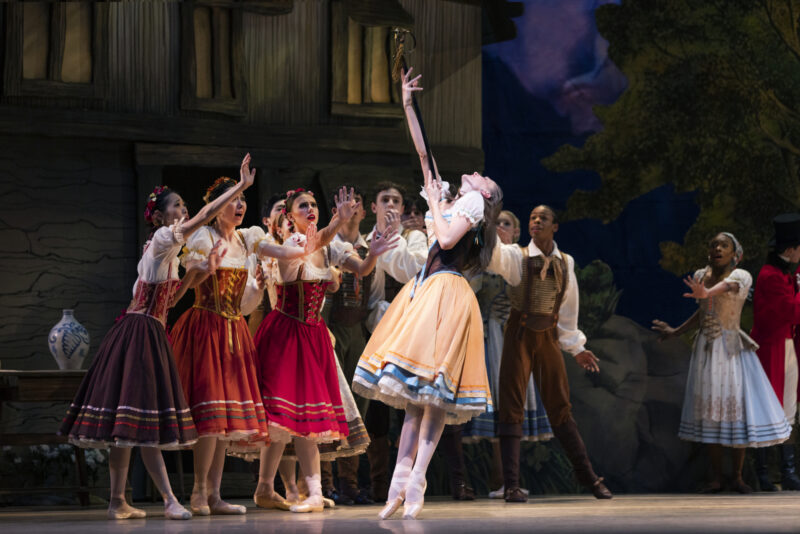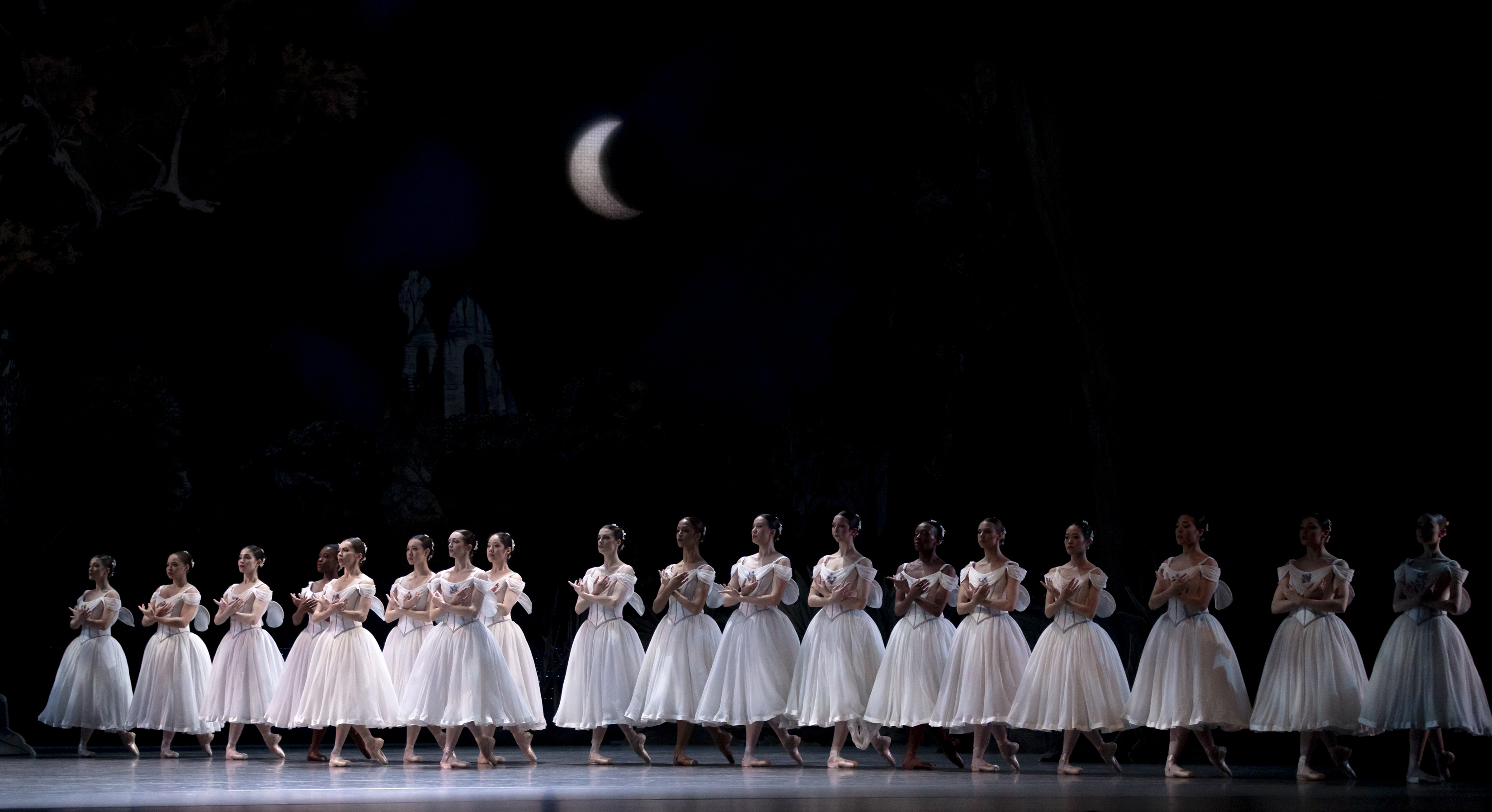PNB’s "Giselle": A Skilled Interpretation of the Famous Tragedy
Review of Giselle at Pacific Northwest Ballet
Written by Teen Writer Kayla Shin and edited by Audrey Gray

The lights dimmed in McCaw Hall's massive theater, filled to the brim with people of all ages, eagerly anticipating the overture of a bittersweet romance and haunting tragedy. There was a distant sound of tuning in the orchestra pit, barely heard over the clamor of excited viewers. Suddenly, a moment of stillness. Then, the thrilling first note of Giselle’s opening theme—an upbeat melody that didn’t prepare the audience for the devastating story that lay ahead. Before the hushed audience, the performers of Pacific Northwest Ballet (PNB) waited behind the curtains to present a unique perspective on the famous ballet for the company’s first production since 2014.
The story of Giselle dates back to the 19th century, first performed at the Ballet du Théâtre de l'Académie Royal de Musique in Paris. Theophile Gautier, the original creator of the celebrated ballet, devised the art after reading two old ghost stories: “Phantoms,” by Victor Hugo, and On Germany, by Heinrich Heine. Essentially, the ballet is about a naive peasant girl’s child-like passion for dancing, and a series of tragic events that sentence her to an eternal existence between life and death.
Much of the story is told through pantomimes—familiar movements that are repeated throughout the story. With the rediscovery of original 19th century manuscripts that were formerly lost to time, the Pacific Northwest Ballet was able to create a uniquely accurate presentation and integrate many of the ballet’s original pantomimes into their show. The first act of the ballet is lighthearted; the only conflict is Duke Albert of Silesia (Lucien Postlewaite) and the gamekeeper Hilarion’s (James Yoichi Moore) quarrel over Giselle’s (Elizabeth Murphy) heart, until the very end. Heartfelt, romantic pantomimes animated the dances: hands clasped over the heart for “love”; waving a graceful hand across the face for “beautiful”; pointing at the ring finger for “marry.”
However, there are small hiccups in movements that foreshadow the tragic second act of the ballet and Giselle’s heartbreaking fate: the arms crossed over each other for “death,” a slow opening of the arms in a bow for “the Earth opens,” one hand on the head for “exhaustion.” The flurrying of the arms upwards for “dance,” lighthearted at first, quickly takes a dark turn after Giselle’s death at the end of Act I. Giselle, ignoring her mother’s warnings of the Wilis (sorrowful young women who had died before marriage), inevitably transforms into one of the ghostly creatures, sentenced to dance and lure wandering men to their deaths for the rest of her eternal existence.

I found these inclusions in the show to be a cohesive element that completed an already elegant performance. The dancers especially did a wonderful job acting out this depiction of the story. Murphy, Postlewaite, and Moore’s portrayal of a doomed love triangle created a memorable experience for the audience, where each character’s feelings of love, dread, and hatred felt real. From Hilarion’s longing for Giselle, to Giselle and Albert’s affection and misunderstanding, the ballet’s outstanding incorporation of pantomimes along with dance preserves and heightens the emotional atmosphere that the dancers sought to create.
Cecelia Iliesiu’s performance as Myrtha, the Queen of the Wilis, was exceptionally compelling. This performance was her debut as the cruel queen, and her portrayal differed from the traditional characterization of Myrtha. Myrtha is often seen as a character without much empathy or emotion, described as inhuman, a ghostly figure whose only role is to lead men to their deaths. However, Iliesiu looked to give an air of humanity to the character; she was not an “ice princess” who was forcing Giselle and Albert apart, but a heartbroken woman who had once been like them. Giselle and Albert’s dance becomes a chance to prove their love, rather than a struggle for love against a malicious spirit. Iliesiu captures the essence of this idea with the statement “I loved once too; let me give them a chance.”
On top of these elements of ballet, the performance would not be complete without the orchestra, led by Josh Archibald-Seiffer. Throughout this ballet, music plays a large role in the emotional impact of the dancing. Giselle was written during the early Romantic period, meaning that because much of art music during this period was limited to certain keys and chords, it is partially up to the conductor and musicians to make sure that it portrays the emotions intended.
In Act II of Giselle, there is a bewitching viola solo during Albert and Giselle’s dance together, known as their “pas de deux”—a dance proclaiming their love for each other from beyond the grave. Alex Grimes’ interpretation of the solo brings a heartwarming, almost playful attitude to the scene.
The pas de deux begins in a major key, a slow and sweet melody that travels up and down the instrument’s register. Without the ballet’s context, this piece sounds like a romantic back and forth between two lovers. However, the reality of the situation is far from joyful. I interpreted this to be a bittersweet reminder of when Giselle was still alive and the two had still been together. This is where the musical interpretation of the orchestra comes into play. For each performance, Grimes has to take the deceptively lighthearted melody, and mold it into something that is longing, but ultimately tragic. He succeeds in doing so, utilizing the rich tone of the lower strings and the delicate whistle of the upper strings, and phrasing an otherwise uncomplicated movement.
I found his performance, and the entirety of the PNB orchestra’s, very well done. Because the orchestra is ultimately limited to the directions of the dancers, it can be very difficult for musicians to fully express the sentiments of the piece. According to Grimes, the orchestra has to be very flexible with tempo, have a deep understanding and memory of the music, and follow the conductor’s directions at all times. The orchestra’s interpretation of the Giselle score was impressive, especially the amount of emotion that was conveyed through the music despite limitations.
Overall, I believe that the Pacific Northwest Ballet in its entirety captures the essence of what playwright Gautier meant for Giselle to be. This production perfectly balances the emotions of the characters with capable performance and direction. Following the final note of the performance, the audience sat in a final moment of stillness, before the curtains reopened and the theater erupted with applause. The story was over, but the emotional impact that every dancer and musician created is something that will never disappear.
Giselle took place at Pacific Northwest Ballet on February 3 - 12, 2023. For more information see here.
Lead Photo: Pacific Northwest Ballet principal dancer Elizabeth Murphy with company dancers, in a scene from Peter Boal’s staging of Giselle. PNB presents Giselle February 3 – 12, 2023, as part of its 50th Anniversary season. (Streaming digitally February 16 - 20.) Photo © Angela Sterling.
The TeenTix Newsroom is a group of teen writers led by the Teen Editorial Staff. For each review, Newsroom writers work individually with a teen editor to polish their writing for publication. The Teen Editorial Staff is made up of 6 teens who curate the review portion of the TeenTix blog. More information about the Teen Editorial Staff can be found HERE.
The TeenTix Press Corps promotes critical thinking, communication, and information literacy through criticism and journalism practice for teens. For more information about the Press Corps program see HERE.


